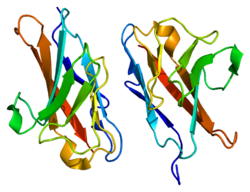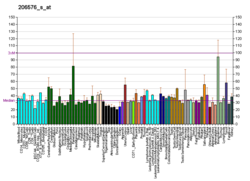Infrastructure tools to support an effective radiation oncology learning health system
Contents
Carcinoembryonic antigen-related cell adhesion molecule 1 (biliary glycoprotein) (CEACAM1) also known as CD66a (Cluster of Differentiation 66a), is a human glycoprotein, and a member of the carcinoembryonic antigen (CEA) gene family.[5]
Function
This gene encodes a member of the carcinoembryonic antigen (CEA) gene family, which belongs to the immunoglobulin superfamily. Two subgroups of the CEA family, the CEA cell adhesion molecules and the pregnancy-specific glycoproteins, are located within a 1.2 Mb cluster on the long arm of chromosome 19. Eleven pseudogenes of the CEA cell adhesion molecule subgroup are also found in the cluster. The encoded protein was originally described in bile ducts of liver as biliary glycoprotein. Subsequently, it was found to be a cell–cell adhesion molecule detected on leukocytes, epithelia, and endothelia. The encoded protein mediates cell adhesion via homophilic as well as heterophilic binding to other proteins of the subgroup. Multiple cellular activities have been attributed to the encoded protein, including roles in the differentiation and arrangement of tissue three-dimensional structure, angiogenesis, apoptosis, tumor suppression, metastasis, and the modulation of innate and adaptive immune responses. Multiple transcript variants encoding different isoforms have been reported, but the full-length nature of only two has been determined.[5]
In melanocytic cells CEACAM1 gene expression may be regulated by MITF.[6]
Interactions
CEACAM1 has been shown to interact with PTPN11[7] and Annexin A2.[8]
See also
References
- ^ a b c GRCh38: Ensembl release 89: ENSG00000079385 – Ensembl, May 2017
- ^ a b c GRCm38: Ensembl release 89: ENSMUSG00000054385 – Ensembl, May 2017
- ^ "Human PubMed Reference:". National Center for Biotechnology Information, U.S. National Library of Medicine.
- ^ "Mouse PubMed Reference:". National Center for Biotechnology Information, U.S. National Library of Medicine.
- ^ a b "Entrez Gene: CEACAM1 carcinoembryonic antigen-related cell adhesion molecule 1 (biliary glycoprotein)".
- ^ Hoek KS, Schlegel NC, Eichhoff OM, Widmer DS, Praetorius C, Einarsson SO, Valgeirsdottir S, Bergsteinsdottir K, Schepsky A, Dummer R, Steingrimsson E (December 2008). "Novel MITF targets identified using a two-step DNA microarray strategy". Pigment Cell & Melanoma Research. 21 (6): 665–76. doi:10.1111/j.1755-148X.2008.00505.x. PMID 19067971. S2CID 24698373.
- ^ Huber M, Izzi L, Grondin P, Houde C, Kunath T, Veillette A, Beauchemin N (January 1999). "The carboxyl-terminal region of biliary glycoprotein controls its tyrosine phosphorylation and association with protein-tyrosine phosphatases SHP-1 and SHP-2 in epithelial cells". The Journal of Biological Chemistry. 274 (1): 335–44. doi:10.1074/jbc.274.1.335. PMID 9867848.
- ^ Kirshner J, Schumann D, Shively JE (December 2003). "CEACAM1, a cell-cell adhesion molecule, directly associates with annexin II in a three-dimensional model of mammary morphogenesis". The Journal of Biological Chemistry. 278 (50): 50338–45. doi:10.1074/jbc.M309115200. PMID 14522961.
Further reading
- Gray-Owen SD, Blumberg RS (June 2006). "CEACAM1: contact-dependent control of immunity". Nature Reviews. Immunology. 6 (6): 433–46. doi:10.1038/nri1864. PMID 16724098. S2CID 34156579.
- Svenberg T, Hammarström S, Zeromski J (June 1979). "Immunofluorescence studies on the occurrence and localization of the CEA-related biliary glycoprotein I (BGP I) in normal human gastrointestinal tissues". Clinical and Experimental Immunology. 36 (3): 436–41. PMC 1537745. PMID 385181.
- Thompson J, Zimmermann W, Osthus-Bugat P, Schleussner C, Eades-Perner AM, Barnert S, Von Kleist S, Willcocks T, Craig I, Tynan K (April 1992). "Long-range chromosomal mapping of the carcinoembryonic antigen (CEA) gene family cluster". Genomics. 12 (4): 761–72. doi:10.1016/0888-7543(92)90307-E. PMID 1572649.
- Kuroki M, Arakawa F, Matsuo Y, Oikawa S, Nakazato H, Matsuoka Y (April 1991). "Three novel molecular forms of biliary glycoprotein deduced from cDNA clones from a human leukocyte library". Biochemical and Biophysical Research Communications. 176 (2): 578–85. doi:10.1016/S0006-291X(05)80223-2. PMID 2025273.
- Hinoda Y, Neumaier M, Hefta SA, Drzeniek Z, Wagener C, Shively L, Hefta LJ, Shively JE, Paxton RJ (September 1988). "Molecular cloning of a cDNA coding biliary glycoprotein I: primary structure of a glycoprotein immunologically crossreactive with carcinoembryonic antigen". Proceedings of the National Academy of Sciences of the United States of America. 85 (18): 6959–63. Bibcode:1988PNAS...85.6959H. doi:10.1073/pnas.85.18.6959. PMC 282098. PMID 2457922.
- Barnett TR, Kretschmer A, Austen DA, Goebel SJ, Hart JT, Elting JJ, Kamarck ME (February 1989). "Carcinoembryonic antigens: alternative splicing accounts for the multiple mRNAs that code for novel members of the carcinoembryonic antigen family". The Journal of Cell Biology. 108 (2): 267–76. doi:10.1083/jcb.108.2.267. PMC 2115422. PMID 2537311.
- Neumaier M, Paululat S, Chan A, Matthaes P, Wagener C (November 1993). "Biliary glycoprotein, a potential human cell adhesion molecule, is down-regulated in colorectal carcinomas". Proceedings of the National Academy of Sciences of the United States of America. 90 (22): 10744–8. Bibcode:1993PNAS...9010744N. doi:10.1073/pnas.90.22.10744. PMC 47854. PMID 7504281.
- Formisano P, Najjar SM, Gross CN, Philippe N, Oriente F, Kern-Buell CL, Accili D, Gorden P (October 1995). "Receptor-mediated internalization of insulin. Potential role of pp120/HA4, a substrate of the insulin receptor kinase". The Journal of Biological Chemistry. 270 (41): 24073–7. doi:10.1074/jbc.270.26.15844. PMID 7592607.
- Frängsmyr L, Baranov V, Prall F, Yeung MM, Wagener C, Hammarström S (July 1995). "Cell- and region-specific expression of biliary glycoprotein and its messenger RNA in normal human colonic mucosa". Cancer Research. 55 (14): 2963–7. PMID 7606710.
- Najjar SM, Philippe N, Suzuki Y, Ignacio GA, Formisano P, Accili D, Taylor SI (July 1995). "Insulin-stimulated phosphorylation of recombinant pp120/HA4, an endogenous substrate of the insulin receptor tyrosine kinase". Biochemistry. 34 (29): 9341–9. doi:10.1021/bi00029a009. PMID 7626603.
- Nédellec P, Turbide C, Beauchemin N (July 1995). "Characterization and transcriptional activity of the mouse biliary glycoprotein 1 gene, a carcinoembryonic antigen-related gene". European Journal of Biochemistry. 231 (1): 104–14. doi:10.1111/j.1432-1033.1995.tb20676.x. PMID 7628460.
- Watt SM, Fawcett J, Murdoch SJ, Teixeira AM, Gschmeissner SE, Hajibagheri NM, Simmons DL (July 1994). "CD66 identifies the biliary glycoprotein (BGP) adhesion molecule: cloning, expression, and adhesion functions of the BGPc splice variant". Blood. 84 (1): 200–10. doi:10.1182/blood.V84.1.200.200. PMID 8018919.
- Hauck W, Nédellec P, Turbide C, Stanners CP, Barnett TR, Beauchemin N (July 1994). "Transcriptional control of the human biliary glycoprotein gene, a CEA gene family member down-regulated in colorectal carcinomas". European Journal of Biochemistry. 223 (2): 529–41. doi:10.1111/j.1432-1033.1994.tb19022.x. PMID 8055923.
- Barnett TR, Drake L, Pickle W (February 1993). "Human biliary glycoprotein gene: characterization of a family of novel alternatively spliced RNAs and their expressed proteins". Molecular and Cellular Biology. 13 (2): 1273–82. doi:10.1128/mcb.13.2.1273. PMC 359012. PMID 8423792.
- Kuroki M, Yamanaka T, Matsuo Y, Oikawa S, Nakazato H, Matsuoka Y (August 1995). "Immunochemical analysis of carcinoembryonic antigen (CEA)-related antigens differentially localized in intracellular granules of human neutrophils". Immunological Investigations. 24 (5): 829–43. doi:10.3109/08820139509060710. PMID 8543346.
- Huber M, Izzi L, Grondin P, Houde C, Kunath T, Veillette A, Beauchemin N (January 1999). "The carboxyl-terminal region of biliary glycoprotein controls its tyrosine phosphorylation and association with protein-tyrosine phosphatases SHP-1 and SHP-2 in epithelial cells". The Journal of Biological Chemistry. 274 (1): 335–44. doi:10.1074/jbc.274.1.335. PMID 9867848.
- Feuk-Lagerstedt E, Jordan ET, Leffler H, Dahlgren C, Karlsson A (November 1999). "Identification of CD66a and CD66b as the major galectin-3 receptor candidates in human neutrophils". Journal of Immunology. 163 (10): 5592–8. doi:10.4049/jimmunol.163.10.5592. PMID 10553088.
- Soni P, Lakkis M, Poy MN, Fernström MA, Najjar SM (June 2000). "The differential effects of pp120 (Ceacam 1) on the mitogenic action of insulin and insulin-like growth factor 1 are regulated by the nonconserved tyrosine 1316 in the insulin receptor". Molecular and Cellular Biology. 20 (11): 3896–905. doi:10.1128/MCB.20.11.3896-3905.2000. PMC 85733. PMID 10805733.
- Ergün S, Kilik N, Ziegeler G, Hansen A, Nollau P, Götze J, Wurmbach JH, Horst A, Weil J, Fernando M, Wagener C (February 2000). "CEA-related cell adhesion molecule 1: a potent angiogenic factor and a major effector of vascular endothelial growth factor". Molecular Cell. 5 (2): 311–20. doi:10.1016/S1097-2765(00)80426-8. PMID 10882072.
- Wang L, Lin SH, Wu WG, Kemp BL, Walsh GL, Hong WK, Mao L (August 2000). "C-CAM1, a candidate tumor suppressor gene, is abnormally expressed in primary lung cancers". Clinical Cancer Research. 6 (8): 2988–93. PMID 10955775.
External links
- CEACAM1+protein,+human at the U.S. National Library of Medicine Medical Subject Headings (MeSH)
- Human CEACAM1 genome location and CEACAM1 gene details page in the UCSC Genome Browser.
This article incorporates text from the United States National Library of Medicine, which is in the public domain.


























